Patrick
This week, Yip and I are going to run a little switch-em-up because Syndicate was primarily my jam. While I did have to make sure that there were enough interaction points between the Syndicate and the other teams in Marvel Team-Up, Yip basically gave me free reign to do what I wanted once I explained my initial design vision.
I’m a big fan of blowing up resources to pay costs. Part of that is because I love a good rush deck, and KO’ing resources means less in a rush deck than in a traditional curve deck. The major reason, though, is that because resources are so valuable—so sacred—in the average game of Vs. System, throwing them away somewhat casually seems cool to me. From this, the idea of “at the start of your combat phase, lose endurance equal to the number of resources you control” seemed pretty natural. It would place emphasis on ending the game as quickly as possible, and would encourage players to KO their own resources to mitigate the costs of these characters. This was the very first concept I had involving Syndicate.
From there, I went back to Web of Spider-Man to get a better feel for what the Syndicate was all about. They were an aggressive off-curve team with some history of paying endurance for aggressive outputs, so my concept for the team synched up with the previous incarnation. The old Syndicate was also pretty heavily steeped in Finishing Move effects, which also addressed another concern of mine. While resources are super valuable, they really don’t mean much on the last turn of the game. I was concerned about players playing a normal game of Vs. with Syndicate until their last initiative, and then KO’ing their resources to pump their characters or burn their opponents out. KO effects are not that exciting on the last turn of the game, so making quality finishing moves that required KO costs would encourage some resource KO’ing before the last turn of the game.
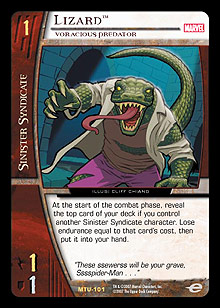 I also wanted to direct players toward a certain style of deck; I wanted Syndicate to be a team where even a new player could take a look at the cards and have an idea of what they should be doing. This was easy enough to accomplish by frontloading the drops on the team (Syndicate has far more 1- and 2-drops than most of our teams), by repeating clauses (mostly “lose endurance equal to the number of resources”), and by creating redundant outputs (lots of high ATK / low DEF characters, a couple of big poly-ATK pumps) that could immediately point players to what style of deck they should be constructing. Moreover, I wanted to design the team without a direct character search card in mind. In many competitive decks nowadays, there is certainly a goal to hit the same suite of characters every single game, which can sometimes lead to a stale playing experience. I wanted to create a team without a direct searcher, which, combined with the KO’ing of resources, would (hopefully) lead to a different experience each time you picked up the deck. Of course, Syndicate did get some effects to address consistency (Lizard, Voracious Predator; The Vault; Legacy of Evil), and Mobilize does throw in a bit of a generic consistency, but in the end I’m glad that Syndicate was deemed competitive enough without needing its own character searcher.
I also wanted to direct players toward a certain style of deck; I wanted Syndicate to be a team where even a new player could take a look at the cards and have an idea of what they should be doing. This was easy enough to accomplish by frontloading the drops on the team (Syndicate has far more 1- and 2-drops than most of our teams), by repeating clauses (mostly “lose endurance equal to the number of resources”), and by creating redundant outputs (lots of high ATK / low DEF characters, a couple of big poly-ATK pumps) that could immediately point players to what style of deck they should be constructing. Moreover, I wanted to design the team without a direct character search card in mind. In many competitive decks nowadays, there is certainly a goal to hit the same suite of characters every single game, which can sometimes lead to a stale playing experience. I wanted to create a team without a direct searcher, which, combined with the KO’ing of resources, would (hopefully) lead to a different experience each time you picked up the deck. Of course, Syndicate did get some effects to address consistency (Lizard, Voracious Predator; The Vault; Legacy of Evil), and Mobilize does throw in a bit of a generic consistency, but in the end I’m glad that Syndicate was deemed competitive enough without needing its own character searcher.
Lastly, there was the issue of alternate boost. Yip and I had discussed using different methods of boost in this set, since it seemed like there was literally infinite design space available there. Since Syndicate was going to “pay costs” more than the other teams, it seemed like they would end up getting the lion’s share of the alternate boost cards. The synergy between KO’ing a resource as a boost cost and the “lose endurance” characters seemed pretty cool, and it wound up on three different characters in the end. Venom was made to address the uniqueness issues that off-curve decks have, Albert Malik ◊ Red Skull was part of the Team-Up searcher cycle, and Spot was created to alleviate some of development’s concern that Syndicate’s play pattern was too extreme to use in Sealed Pack play.
In the end, Syndicate ended up being my homage to Vs. System as a game; the team is one that I would have enjoyed tremendously as a player. That isn’t to say that designers don’t try to make all their teams enjoyable, but the Syndicate is literally an expression of the things that I find enjoyable about the game itself: a pretty high variance in draws, a high risk/reward strategy, and a strategy that largely emphasizes the combat phase. I know that not every player out there will enjoy constructing a deck full of cards that destroy their own resources or eat away all their endurance, but I think there are a lot of rewarding decisions involved in that type of deck construction and play. While the play pattern can seem like a mindless rush of cheap characters on the surface, the team really rewards players who are careful about their recruits, the use of their attack pumps, and the timing of KO’ing their own resources. If winning the game of inches is for you, then I think you’ll find Syndicate to be a lot of fun.
As a sort of postscript to this, I had very little to do with Dr. Octopus, Master of Evil, who was perhaps the most literal interpretation of any character in the entire set. Neither did Billy or Andrew. In a rare display of design know-how, Lead Developer Dave Humpherys cranked out the “use only four times per turn” clause that turned this guy into a thematic home run. This is the same man who said, “I had never heard of Dr. Doom before taking this job.” Pretty impressive, I’d say.
Andrew
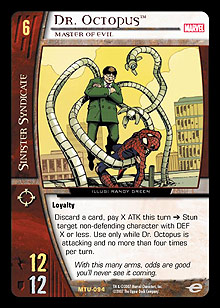 Since the Sinister Syndicate was more Patrick’s design focus than mine, my main concern was the relationship of the team to the others in the set—particularly Spider-Friends. What we omitted talking about last week was the “pay” mechanic that appears on Spider-Friends and Sinister Syndicate. Paying ATK first saw the light of day during the Inhumans design. During that time, I was trying to represent the Inhumans’ reluctance to interact with the outside world. Yet the flavor of the mechanic felt more pacifist than isolationist. So when it came around to designing Spider-Friends, a classic “do-gooders who don’t kill bad guys” team, “pay ATK” popped up and offered its services again. The implementation of pay ATK for Spider-Friends represented their good intentions, and their attempts to arrest and not murder.
Since the Sinister Syndicate was more Patrick’s design focus than mine, my main concern was the relationship of the team to the others in the set—particularly Spider-Friends. What we omitted talking about last week was the “pay” mechanic that appears on Spider-Friends and Sinister Syndicate. Paying ATK first saw the light of day during the Inhumans design. During that time, I was trying to represent the Inhumans’ reluctance to interact with the outside world. Yet the flavor of the mechanic felt more pacifist than isolationist. So when it came around to designing Spider-Friends, a classic “do-gooders who don’t kill bad guys” team, “pay ATK” popped up and offered its services again. The implementation of pay ATK for Spider-Friends represented their good intentions, and their attempts to arrest and not murder.
Conveniently, pay DEF worked well thematically and mechanically on Sinister Syndicate. As the philosophical opposites and arch-nemeses of the Spider-Friends, the Sinister Syndicate got the job done by any means necessary. Frequently, this meant sacrificing for short-term gain and going all-out using whatever resources were available. Pay DEF fit into this scheme quite easily, and was much more flexible than stunning or KO’ing was for assigning costs to powers (Mendel Stromm). It also enabled cool in-combat tricks, with effects ranging from the somewhat boring Black Tarantula to the explosive Dr. Octopus, Master of Evil.
Pay ATK and pay DEF on Spider-Friends and Sinister Syndicate were two of several ways in which teams were defined in Marvel Team-Up; in addition to their personal identities, who they fought and who they fought beside were deliberately depicted.
Billy
Continuing along the same line of thought, I want to show you how we linked the Spider-Friends and the Sinister Syndicate in the art through setting and time of day. The Spider-Friends art requests broke down into four basic groupings, with subtle changes when switching from day to night: Concrete Jungle, Rooftops, City Streets (Back Alley), and Central Park (Graveyard). Concrete Jungle portrayed the characters like Venom, Lethal Protector; Spider-Man, The Sensational Spider-Man. and Darkhawk maneuvering/swinging/flying through and between the skyscrapers. The ideas behind Rooftops, City Streets, and Central Park are pretty self-explanatory: guys on rooftops like Daredevil, New Kingpin; guys in the city streets like Luke Cage, Neighborhood Watch; and the “Jungle Crew” in Central Park. (Yes, Ka-Zar, Shanna the She-Devil, and Zabu are chillin’ in Central Park.) With the Spider-Friends, we portrayed the characters that fell into these groups as “patrolling” the city of New York. But if we’re going to have these characters patrolling, then we’re going to need some evil-doers doing evil things to patrol.
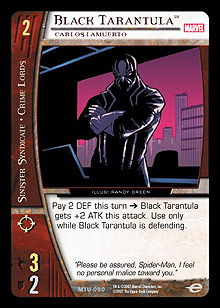 The criminal set, played by the morally bankrupt Sinister Syndicate, also appeared in four main groupings: Concrete Jungle, Rooftops, City Streets, and Secret Hideout. Of course, there was a little more variation with these characters. Criminal masterminds like Albert Malik ◊ Red Skull and Black Tarantula appear in high-rise offices (Secret Hideout), while bread and butter thugs like Francis Klum ◊ Mysterio and Spot appear on the Brooklyn Bridge and a bank vault (City Streets), respectively.
The criminal set, played by the morally bankrupt Sinister Syndicate, also appeared in four main groupings: Concrete Jungle, Rooftops, City Streets, and Secret Hideout. Of course, there was a little more variation with these characters. Criminal masterminds like Albert Malik ◊ Red Skull and Black Tarantula appear in high-rise offices (Secret Hideout), while bread and butter thugs like Francis Klum ◊ Mysterio and Spot appear on the Brooklyn Bridge and a bank vault (City Streets), respectively.
We set both teams in New York so that we could expect the maximum amount of overlapping activity from them, whether criminal or neighborly. Some of the characters didn’t exactly fit into these restrictive groupings, however, such as:
The Sentry
Setting: In the Clouds - Day
Action: The Sentry hovers in the clouds. He partially blocks the sun, whose rays cascade off his cape and back. The Sentry has his right arm outstretched toward the viewer with his palm facing down. He casts a stern gaze toward the viewer.
Focus: The Sentry
Tone: Majestic, Stunning
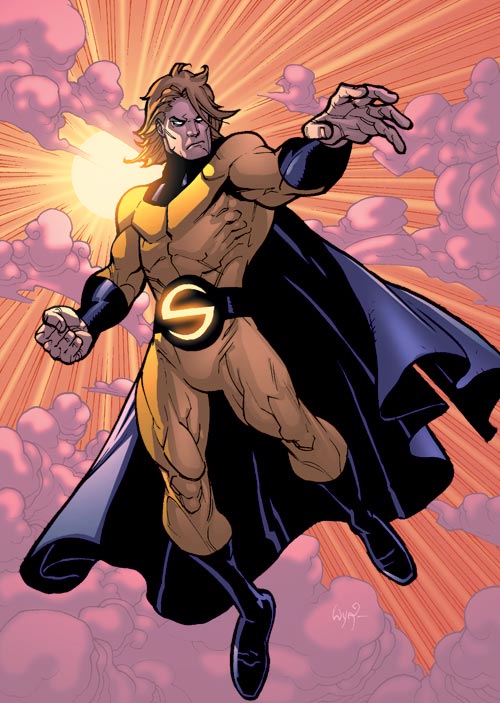
And, of course, everyone’s favorite non-Herald:
Aunt May, Golden Oldie
Setting: Space, Low Earth Orbit
Action: Aunt May is Golden Oldie, the newest Herald of Galactus! She flies around the Earth, smiling ear to ear, enjoying the freedom the power cosmic provides. In the distance, the sun rises.
Focus: Aunt May as Golden Oldie
Keywords: Victim turned Superhero
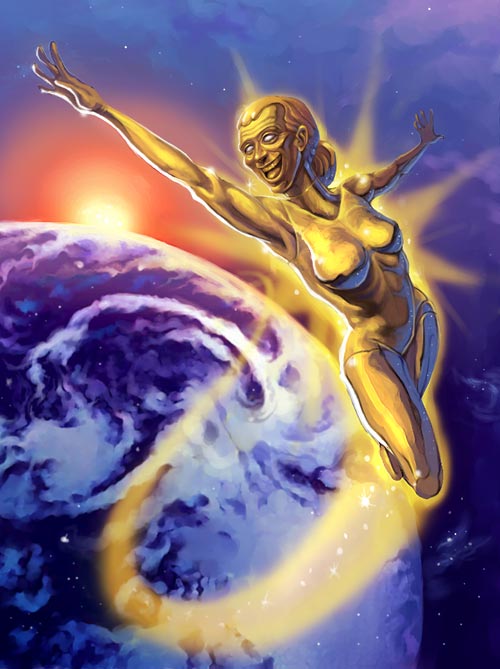
I’ll talk more about art descriptions next week, when we tackle the Defenders. You’ll find out just how embarrassing it can actually be to be on The “B” Team.
Selected Card Bibliography
- Albert Malik ◊ Red Skull: Amazing Spider-Man Vol. 1 #366
- Black Tarantula: Amazing Spider-Man Vol. 1 #436
- Francis Klum ◊ Mysterio: Spider-Man and the Black Cat #1-6
- Fusion Spider-Man Vol. 2 #32
- Gog: Spider-Man Vol. 1 #23
- Harry Osborn ◊ Green Goblin: Spectacular Spider-Man Vol. 1 #200
- Nitro: Spider-Man Vol. 1 #95
- Razorfist: Toxin #1-6
- Spider-Man Robot: Avengers Vol. 1 #11
- Spider-Slayer V.X.: Amazing Spider-Man Vol. 1 #368
- Venom, Mac Gargan: Mark Knights Spider-Man #8
- Alien Symbiote: Amazing Spider-Man Vol. 1 #410
- Breakout: New Avengers #1
- Demonic Association: Spider-Man Vol. 1 #24
- Gotcha!: Spectacular Spider-Man Vol. 1 #189
- Legion of Losers: Spectacular Spider-Man Vol. 1 #246
- Spider Hunt: Sensational Spider-Man Vol. 1 #25